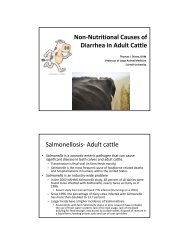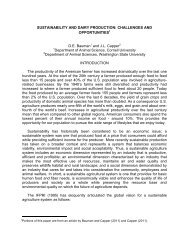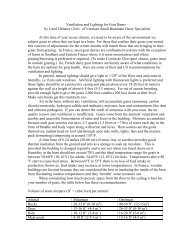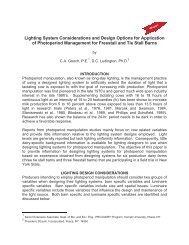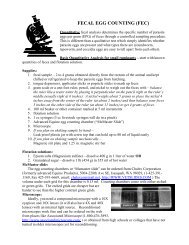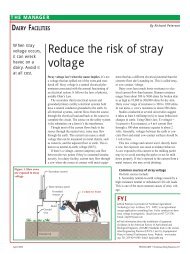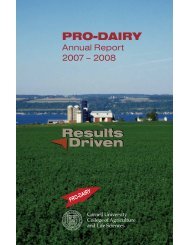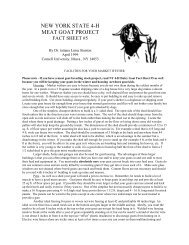2009 Proceedings of the Cornell Nutrition Conference For Feed ...
2009 Proceedings of the Cornell Nutrition Conference For Feed ...
2009 Proceedings of the Cornell Nutrition Conference For Feed ...
Create successful ePaper yourself
Turn your PDF publications into a flip-book with our unique Google optimized e-Paper software.
Table 1. Efficiency factors for use <strong>of</strong> amino acids for maintenance and lactation with<br />
indices <strong>of</strong> variation provided for mammary gland efficiencies <strong>of</strong> use.<br />
Maintenance<br />
efficiency <strong>of</strong><br />
Lactation (mammary gland utilization)<br />
Standard<br />
Deviation<br />
Coefficient <strong>of</strong><br />
Variation<br />
AA<br />
Efficiency <strong>of</strong><br />
use<br />
use<br />
Met 0.85 1.00 0.10 10%<br />
Lys 0.85 0.86 0.13 16%<br />
His 0.85 0.94 0.13 14%<br />
Phe 0.85 0.98 0.08 8%<br />
Trp 0.85 0.85 NA NA<br />
Thr 0.85 0.79 0.14 18%<br />
Leu 0.66 0.71 0.07 10%<br />
Ile 0.66 0.66 0.07 11%<br />
Val 0.66 0.62 0.09 14%<br />
Arg 0.85 0.34 0.06 17%<br />
Source <strong>of</strong> Energy and Metabolic Regulation<br />
Data generated over <strong>the</strong> last 15 years demonstrate that <strong>the</strong> site <strong>of</strong> absorption <strong>of</strong><br />
starch and sugars, and <strong>the</strong> form <strong>of</strong> substrate, ei<strong>the</strong>r glucose in <strong>the</strong> small intestine or<br />
propionate, might impact <strong>the</strong> animal response to <strong>the</strong> nutrient and potentially <strong>the</strong><br />
endocrine signaling in a manner that could affect <strong>the</strong> efficiency <strong>of</strong> use <strong>of</strong> absorbed AA<br />
(Knowlton et al., 1998, Rulquin et al., 2004; Raggio et al., 2006, Reynolds, 2006;<br />
Lemosquet et al. <strong>2009</strong>). These data suggest that as starch is digested in <strong>the</strong> small<br />
intestine, <strong>the</strong> transfer <strong>of</strong> glucose into <strong>the</strong> circulation increases, but <strong>the</strong> efficiency <strong>of</strong><br />
transfer <strong>of</strong> <strong>the</strong> glucose carbon into lactose production decreases, thus decreasing <strong>the</strong><br />
efficiency <strong>of</strong> use <strong>of</strong> absorbed AA. Reynolds (2006) summarized several studies and<br />
concluded that although <strong>the</strong>re is an increase in glucose availability, <strong>the</strong> tissues drained<br />
by <strong>the</strong> portal vein appear to preferentially utilize <strong>the</strong> glucose and in addition retain<br />
slightly greater body protein. There is an apparent increase in milk volume, but milk fat<br />
content decreases so that <strong>the</strong> energy output <strong>of</strong> <strong>the</strong> cow is not increased. With<br />
increased post-ruminal starch digestion <strong>the</strong>re is a change in insulin status, but under <strong>the</strong><br />
conditions study to date, it does not translate into greater milk protein output. Currently<br />
in <strong>the</strong> CNCPS, although <strong>the</strong> model calculates <strong>the</strong> amount <strong>of</strong> starch digested in <strong>the</strong><br />
rumen and small intestine, <strong>the</strong>re is no provision for changes in how <strong>the</strong> model treats<br />
energy absorbed as glucose in <strong>the</strong> small intestine versus energy yield from ruminal<br />
digestion. To enhance <strong>the</strong> sensitivity <strong>of</strong> <strong>the</strong> model, we need to make adjustments for<br />
post-ruminal starch digestion that describes <strong>the</strong> fate <strong>of</strong> that energy in a more<br />
mechanistic approach – this should allow us to enhance <strong>the</strong> prediction <strong>of</strong> efficiency <strong>of</strong><br />
use <strong>of</strong> absorbed AA.<br />
Efficiency <strong>of</strong> use <strong>of</strong> AA is a combination <strong>of</strong> <strong>the</strong> energy allowable production and <strong>the</strong>n<br />
<strong>the</strong> ability to balance <strong>the</strong> pr<strong>of</strong>ile and supply <strong>of</strong> AA to meet <strong>the</strong> energy driven demand. It<br />
is well known that particular hormones such as insulin, IGF-I, and cortisol to name a few<br />
have a pr<strong>of</strong>ound impact on protein syn<strong>the</strong>sis in <strong>the</strong> mammary gland, thus can alter <strong>the</strong><br />
33



